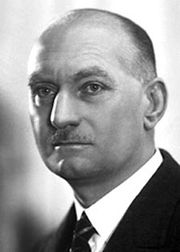كورناي هايمانز
كورناي هايمانز Corneille Heymans | |
|---|---|
 | |
| وُلِدَ | 28 مارس 1892 |
| توفي | 18 يوليو 1968 (aged 76) |
| الجنسية | بلجيكا |
| المدرسة الأم | جامعة خنت |
| اللقب | ضغط الأوعية الدموية وتحكم المستقبلات الكيميائية في الجهاز التنفسي (ضغط الدم) |
| الجوائز | جائزة نوبل في الفسيولوجيا أو الطب (1938) |
| السيرة العلمية | |
| المجالات | علم وظائف الأعضاء |
| الهيئات | جامعة خنت |
| طلاب الدكتوراه | پول يانسن |
كورناي هايمانس أو كورناي جان فرنسوا هايمانس (و. 28 مارس 1892 - ت. 18 يوليو 1968). حصل على جائزة نوبل في الفسيولوجيا أو الطب عام 1938 لايضاحه كيفية قياس ضغط الدم ومحتوى الاكسجين في الدم المنقول إلى المخ والجسم.
. . . . . . . . . . . . . . . . . . . . . . . . . . . . . . . . . . . . . . . . . . . . . . . . . . . . . . . . . . . . . . . . . . . . . . . . . . . . . . . . . . . . . . . . . . . . . . . . . . . . . . . . . . . . . . . . . . . . . . . . . . . . . . . . . . . . . . . . . . . . . . . . . . . . . . . . . . . . . . . . . . . . . . . .
النشأة والتعليم
After graduation Heymans worked at the كلية فرنسا (under Prof. E. Gley), the University of Lausanne (under Prof. M. Arthus)، جامعة ڤيينا (under Prof. H. H. Meyer), University College London (under Prof. E. H. Starling) and Case Western Reserve University School of Medicine (under Prof. C. F. Wiggers).[1] In 1922 Heymans became lecturer in Pharmacodynamics at Ghent University, and in 1930 succeeded his father, Jean-François Heymans, as Professor of Pharmacology, as well as being appointed Head of the Department of Pharmacology, Pharmacodynamics, and Toxicology; and Director of the J. F. Heymans Institute.[1]
البحث
Heymans was awarded the Nobel Prize for Physiology or Medicine in 1938 for showing how blood pressure and the oxygen content of the blood are measured in the body and transmitted to the brain via the nerves and not by the blood itself.
Heymans accomplished this by vivisection of two dogs, the head of one connected to its body only by nerves, and the second one's body was used to cross-perfuse (supply blood) to the first dog's head. Heymans found that the first dog's upward and downward cardiovascular reflex arc traffic were carried by its own vagus nerves, but agents introduced to the second dog's blood, which served the first dog's brain, had no effect. He used a similar experiment to demonstrate the role of peripheral chemoreceptors in respiratory regulation, for which he received his Nobel Prize.[2]
He was the Editor-in-Chief of Archives Internationales de Pharmacodynamie et de Thérapie for many years. His memberships included the Pontifical Academy of Sciences, the Académie des Sciences, and the Royal Society of Arts.[3]
The group of physiopharmacologists working under Heymans at Ghent University were looking for the anatomical basis of the respiratory reflex at the carotid sinus. It was necessary that the Spanish neurohistologist Fernando de Castro Rodríguez (1898–1967) described in detail the innervation of the aorta-carotid region, circumscribing the presence of baroreceptors to the carotid sinus, but that of chemoreceptors to the carotid body, for the Belgian group to move their focus from the first to the very small second structure to physiologically demonstrate the nature and function of the first blood chemoreceptors.[4] The contribution of the young De Castro, maybe the last direct disciple of Santiago Ramón y Cajal (1852–1934; awarded the 1906 Nobel prize in Physiology or Medicine) was overlooked at the time, but it was later recognized[بحاجة لمصدر] that he deserved to share the Nobel Prize with Heymans, his colleague and friend.
الحياة الشخصية
Heymans married Berthe May (1892–1974), an ophthalmologist, in 1929 and had five children. وقد توفي في كنوكه بنوبة قلبية.
التكريم والجوائز
- هايمانز (فوهة) على سطح القمر
- Nobel Prize for Physiology or Medicine (1938)
- Member, American Philosophical Society (1962)[5]
المصادر
- ^ أ ب خطأ استشهاد: وسم
<ref>غير صحيح؛ لا نص تم توفيره للمراجع المسماةnobelbiog - ^ Boron, Walter F. and Emile L. Boulpaep. Medical Physiology. Saunders, 2012, p. 555.
- ^ Chen, K. K. (ed.) (1969) The first sixty years 1908–1969, p.145 Archived 8 يناير 2014 at the Wayback Machine, The American Society for Pharmacology and Experimental Therapeutics .
- ^ de Castro, F. (2009) Towards the sensory nature of the carotid body: Hering, De Castro and Heymans. Front. Neuroanat. 3: 23 (1-11) (doi:10.3389/neuro.05.023.2009).
- ^ "APS Member History". search.amphilsoc.org. Retrieved 2022-11-18.
- Karl Grandin, ed. (1938). "Corneille Heymans Biography". Les Prix Nobel. The Nobel Foundation. Retrieved 2008-07-24.
{{cite web}}:|author=has generic name (help)
وصلات خارجية
- Corneille Heymans, (1892 - 1968), Nobel Prize Winner in Physiology and Medicine 1938
- "Corneille Heymans". The Notable Names Database. 2008. Retrieved 2008-07-24.
